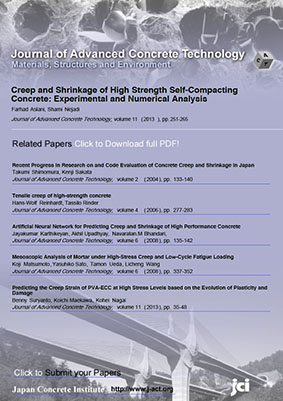All issues

Volume 12, Issue 11
Displaying 1-5 of 5 articles from this issue
- |<
- <
- 1
- >
- >|
Scientific paper
-
Combination Effects of Internal Curing and Permanent Formwork on Shrinkage of High Strength ConcreteJun Zhang, Yu Dong Han, Yiming Luosun2014Volume 12Issue 11 Pages 456-467
Published: November 08, 2014
Released on J-STAGE: November 08, 2014
JOURNAL FREE ACCESSIn this paper, the influences of internal curing using pre-soaked lightweight aggregate (PSLWA) and pre-fabricated fiber reinforced engineered cementitious composite (ECC) board as permanent formwork on shrinkage and internal relative humidity of high strength concrete were investigated. Three mixture proportions with induced curing water-to-cement ratios (WIC/C) of 0, 0.08 and 0.12 were utilized in the experiments. The test results show that the progress of the internal relative humidity of high strength concrete since casting exhibits first a vapor saturated stage (RH=100%, stage I), followed by a gradually reducing stage (RH<100%, stage II). As PSLWA is added, the reduction rate of internal relative humidity in stage II is greatly decreased. As ECC cover is used, the reduction on internal humidity of high strength concrete is further reduced. Shrinkage of high strength concrete decreases with increase of induced internal curing water. However, internal curing cannot completely eliminate the shrinkage of high strength concrete developed in the stage I. The combined effects of internal curing and ECC cover can reduce the shrinkage not only developed in the stage II, but also the shrinkage developed in stage I.View full abstractDownload PDF (1287K) -
Hongjian Du, Kiang Hwee Tan2014Volume 12Issue 11 Pages 468-477
Published: November 09, 2014
Released on J-STAGE: November 09, 2014
JOURNAL FREE ACCESSThe pozzolanic reactivity of waste glass powder was experimentally studied at cement replacement levels of 0, 15, 30, 45 and 60% by weight. Results revealed that the concrete compressive strength was not decreased by the cement substi-tution after 28 days because of the pozzolanic reaction between glass powders and cement hydration products, if the replacement is below 30%. Also, the resistance to chloride ion and water penetration continuously increases with in-creasing glass powder content up to 60% cement replacement. At 60% replacement level, the electrical resistivity and water penetration depth were reduced by 95% and 80%, respectively, while the compressive strength was maintained as 85%. These improvements in durability properties are due to the refined microstructures, particularly at the interfacial transition zone. Pore size distribution was measured to confirm the refinement in the capillary pores, which partially block the pathways for water and chloride ions. This study also demonstrates that high performance concrete (improved strength and impermeability against chloride and water) could be achieved by using glass powder as 15% additive, which contributes to the pozzolanic reaction instead of being inert fines for compact packing.View full abstractDownload PDF (1807K) -
Ji-Hun Choi, Kwang-Hoe Jung, Tae-Kyun Kim, Jang-Ho Jay Kim2014Volume 12Issue 11 Pages 478-495
Published: November 12, 2014
Released on J-STAGE: November 12, 2014
JOURNAL FREE ACCESSA hybrid truss bridge (HTB) is a bridge constructed by replacing the concrete webs of a pre-stressed box girder bridge with steel truss webs. With its open web section, HTB offers advantages of high structural efficiency and excellent aesthetic appearance. The core technology of HTB is the connection system between the steel trusses and the concrete deck. Since the open web section of a HTB decreases the torsional capacity, precise analysis of the torsional behavior of the open web section with respect to the connection joint type is needed to ensure the safety of HTBs. In this study, the tor-sional capacity of HTB was calculated using the torsion formula derived based on the steel plate thickness conversion equation for corrugated steel web plates and the space truss theory. The torsion formula was verified by performing a parametric study using a commercial finite element program. Next, the torsion analysis results of the HTB girder were compared to experimental results to evaluate their accuracy. Finally, the simulation, experimental, and torsion formula results were compared to evaluate the feasibility of using the formula in design.View full abstractDownload PDF (8076K) -
Will Hansen, Zhichao Liu, Eduard A. B. Koenders2014Volume 12Issue 11 Pages 496-502
Published: November 21, 2014
Released on J-STAGE: November 21, 2014
JOURNAL FREE ACCESSThe principal objective in this paper is to determine the internal viscoelastic modulus associated with autogenous shrinkage of cementitious materials. This is accomplished by analyzing autogenous shrinkage of plain and reinforced paste and mortar specimens. The internal restraint from steel reinforcement creates uniaxial tensile stress condition increasing with shrinkage. Data analysis demonstrates a unique internal shrinkage modulus, which eliminates the need for stress relaxation modulus calculations. The internal modulus is in the range of 8000-9000 MPa, while the external composite modulus known as Young’s modulus is 32 000-36 000 MPa for the low water-binder ratio (0.35) concrete.View full abstractDownload PDF (1167K) -
Qingbang Han, Jin Cheng, Honghui Fan, Cheng Yin, Changping Zhu2014Volume 12Issue 11 Pages 503-509
Published: November 26, 2014
Released on J-STAGE: November 27, 2014
JOURNAL FREE ACCESSThis research aims to detect cement grouting defects in corrugated pipes using the ultrasonic impact-echo method. A combined signal processing technique that included de-convolution technique, information entropy and cross-correlation were proposed to identify and characterize defects. Several numerical models were constructed to simulate and analyze the results using the finite element method. The stripping size of the defects in the corrugated pipe was recognized by analyzing the information entropy and correlation coefficients of the echo signals. Experiments were carried out on a concrete specimen containing artificial defects with varying stripping sizes and numbers of elements. The experimental results were consistent with the simulated predictions. .View full abstractDownload PDF (1020K)
- |<
- <
- 1
- >
- >|